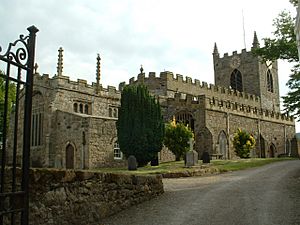St Mary's and St Nicholas's Church, Beaumaris facts for kids
St Mary and St Nicholas Church is an old and important church in Beaumaris, Wales. It was built in the 1300s. This church is a special Grade I listed building, which means it's protected because of its history and beauty.
Contents
The Church's Story
How It Started
This church began around the year 1330. It was first a small chapel. It helped serve the people of the new town of Beaumaris. It was a place for them to worship.
What the Church Looks Like
Inside the Church
The church still has its main part, called the nave, from the 1300s. It has beautiful decorations and arches. The area near the altar, called the chancel, was rebuilt around 1500. It was built in a style called Perpendicular, which means it has tall, straight lines.
The Tower and Outside
The church has a tall tower on its west side. It has four levels and a top that looks like the walls of a castle. The very top part of the tower was updated in the early 1800s. The small room on the north side and the entrance porch on the south side were likely added in the 1800s. The outside of the church mostly shows the Perpendicular style.
Special Features Inside
- Old Seats: You can see wooden seats from the 1500s in the chancel.
- Joan's Coffin: The church holds the coffin and lid of Joan. She was the daughter of John, King of England and married Llywelyn the Great when she was 15.
- Misericords: There are special small seats called misericords from the late 1400s or early 1500s. These were often found in monasteries. Some were replaced in 1902. It's thought the old ones came from a nearby friary called Llan-faes.
- Old Tombs: You can also find the tomb of William Bulkeley, who helped manage Beaumaris Castle around 1490, and his wife. This tomb is made from a special stone called alabaster.
- Monuments: The church has monuments to important people from the 1500s and 1600s. These include Sir Henry Sidney, who was a leader in Wales and Ireland.
The Clock and Bells
The church tower has a set of bells. The town of Beaumaris takes care of the four clock faces and the clock's working parts.
The Churchyard
St Mary's and St Nicholas's Church is in a large churchyard. Church Street is on one side and Steeple Lane is on the other. Many old tombstones made of slate are along the north wall. They tell interesting stories about the people who lived there, like their jobs. There is a large tomb for a local clever person near the south porch. Some other slate tombstones have been damaged over time.
See Also
- Grade I listed buildings in Anglesey
Images for kids



